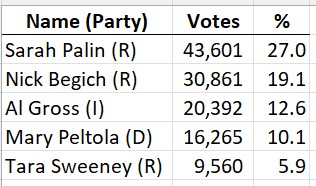Ranked-choice shenanigans in Alaska
Alaskans will have to wait weeks to find out who their new Congressperson is, thanks to the vagaries of the the new ranked-choice voting (RCV) system adopted this year.
On Tuesday, Alaskans voted in their primary election for 2022. Included on the ballot this week was a special election for the state’s lone, at-large Representative to the U.S. Congress.
The incumbent, Don Young, died back in March, having served the state in Congress for a record 49 years. He was 88. The state is currently without any representation in the House.
A primary election for the open seat was held on June 11. Given the state’s geography, much of the voting takes place by mail.
Back in 2020, Alaska voters approved a referendum to adopt the ranked-choice voting system for all state and Federal elections. Beginning this year, instead of party-specific primary races, all candidates run in an single, open primary. The top four candidates, regardless of party, advance to the general election.
At the general election, voters have the chance to rank candidates 1 through 4. If no one gets a majority in the first round, 2nd choices are measured, and so forth.
Former Governor Sarah Palin and 21 other candidates ran in the primary, which finished in this order (top 5):

Palin finished first. The top three Republican candidates received more than half of all votes cast. One Democrat (Peltola) qualified for the general election. After the primary, Independent Al Gross dropped out of the race.
Fast forward to August 16. Here is where we stand as the counting continues:

The Democrat, Peltola, vaulted from 4th to 1st place. The two Republicans split the remaining vote fairly evenly.
Since no candidate received a majority, the race will be decided by 2nd choice votes. The counting of 2nd choice preferences won’t even begin until August 31. Under state law, mail ballots have 15 days after the election to arrive and still be counted. The outcome of the race may take until the first few days of September until it’s determined.
In a standard election there would have been just two candidates — one Democrat and one Republican. The Republican would now be on her way to Congress
As with the special primary in June, a clear majority of Alaska voters opted for a Republican candidate this week. Under RCV, they may not get one.
Guess what? Alaska gets to do it all over again in November. Also on Tuesday’s ballot was the primary election for the regular congressional election in November. In that primary, the order followed the same as the special general election (if you are still following me), with Republican Tara Sweeney (remember her?) finishing fourth out of the 22 candidates.
But they weren’t the same 22 candidates that ran in the June primary. Conspicuous by his absence in the August primary was Santa Claus (not kidding), who previously finished sixth.
Not only does RCV seem uniquely designed to baffle the voter, it seem designed specifically to thwart the intentions of the majority of voters.